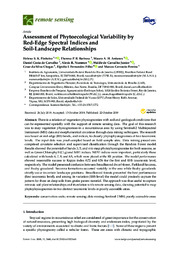Assessment of phytoecological variability by red-edge spectral indices and soil-landscape relationships.
Assessment of phytoecological variability by red-edge spectral indices and soil-landscape relationships.
Author(s): PINHEIRO, H. S. K.; BARBOSA, T. P. R.; ANTUNES, M. A. H.; CARVALHO, D. C. de; NUMMER, A. R.; CARVALHO JUNIOR, W. de; CHAGAS, C. da S.; FERNANDES-FILHO, E. I.; PEREIRA, M. G.
Summary: There is a relation of vegetation physiognomies with soil and geological conditions that can be represented spatially with the support of remote sensing data. The goal of this research was to map vegetation physiognomies in a mountainous area by using Sentinel-2 Multispectral Instrument (MSI) data and morphometrical covariates through data mining techniques. The research was based on red-edge (RE) bands, and indices, to classify phytophysiognomies at two taxonomic levels. The input data was pixel sampled based on field sample sites. Data mining procedures comprised covariate selection and supervised classification through the Random Forest model. Results showed the potential of bands 3, 5, and 6 to map phytophysiognomies for both seasons, as well as Green Chlorophyll (CLg) and SAVI indices. NDVI indices were important, particularly those calculated with bands 6, 7, 8, and 8A, which were placed at the RE position. The model performance showed reasonable success to Kappa index 0.72 and 0.56 for the first and fifth taxonomic level, respectively. The model presented confusion between Broadleaved dwarf-forest, Parkland Savanna, and Bushy grassland. Savanna formations occurred variably in the area while Bushy grasslands strictly occur in certain landscape positions. Broadleaved forests presented the best performance (first taxonomic level), and among its variation (fifth level) the model could precisely capture the pattern for those on deep soils from gneiss parent material. The approach was thus useful to capture intrinsic soil-plant relationships and its relation with remote sensing data, showing potential to map phytophysiognomies in two distinct taxonomic levels in poorly accessible areas.
Publication year: 2019
Types of publication: Journal article
Unit: Embrapa Soils
Observation
Some of Embrapa's publications are published as ePub files. To read them, use or download one of the following free software options to your computer or mobile device. Android: Google Play Books; IOS: iBooks; Windows and Linux: Calibre.
Access other publications
Access the Agricultural Research Database (BDPA) to consult Embrapa's full library collection and records.
Visit Embrapa Bookstore to purchase books and other publications sold by Embrapa.

